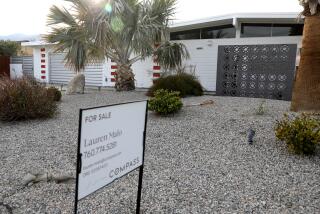Software lets new-home buyers build dream house on a computer
- Share via
There’s no question that the Internet has changed the way most people shop for homes. You can find houses online, take a virtual look around and plot their locations in relation to your kids’ schools, the church of your choice or even your favorite coffeehouse.
Now the Web is taking it up a notch with software that enables new-home buyers to build their dream house. You can pick our your favorite lot, choose from several models and customize the place to your heart’s content, all while sitting at your computer. Then you can print out the final results, take them to the sales office and you’re off and running.
Not every builder offers customization portals. In fact, they are far from universal. But enough companies are starting to adopt the concept that it is becoming a trend.
Although online simulators like Blu Homes’ 3-D Configurator or Kova Solution’s WebPro aren’t likely to replace model homes, they seem destined to change the way builders operate. Research shows that today’s buyers, especially the younger ones, want an interactive experience.
Blu Homes, a builder of novel modular homes, is no stranger to innovation. The company ships its products anywhere in the country from its factory in Vallejo, Calif.
The modules are 8 feet wide instead of the standard 13 feet, so shipping costs are much cheaper than conventional, wide-load sectionalized houses. The modules are built on sturdy steel frames and unfold to 19 feet, with ceilings as high as 16 feet. Each section comes almost completely finished, including plumbing and electrical systems, and they are assembled by Blu’s own construction crews.
But even more inventive is the software the company employs that allows would-be buyers to pick and personalize any of its seven precision-built models. Blu’s realistic, three-dimensional configurator is similar to the software used by such elite industrial giants as Ford Motor Co. and Boeing Co., co-founder Maura McCarthy said.
“We are a technology company that builds houses,” said McCarthy, who was trained as an economist at Georgetown University and has worked with former Federal Reserve Chairman Alan Greenspan. “Boeing used to build test planes. Now it builds virtual test planes, and we do the same thing with our houses.”
With the configurator, buyers can change finishes, appliances, cabinets, hardware, countertops, window treatments, lighting packages and flooring until they find exactly what they’re looking for.
Several more traditional builders are using similar software.
S&A; Homes of State College, Pa., uses interactive smartPLAN technology developed by Graphic Languages of San Francisco. The system allows users to pick a community, pick a house and then make changes, such as adding a fireplace or extending the breakfast room.
Oakwood Homes in Denver, American West Development in Las Vegas and Hayden Homes in the Pacific Northwest are among a handful of builders that use Kova’s end-to-end software system. It guides buyers through product and community options, including selecting the site, plotting the house, picking the elevation, making changes and selecting upgrades. It even allows them to pick a color scheme.
“Our home buyers are fully involved in the customization process,” said Kendra Saffle of American West.
Once buyers have settled on their dream house, they can print out a brochure and take it to the sales office, where an agent has already been assigned to them. Here their house becomes a contract and then a sales order that is the basis for estimating, bidding, purchasing and scheduling, so there is less room for errors along the line.
If there is a drawback with virtual home building, it’s that some builders fail to include pricing. Kova says its clients purposefully leave out prices for competitive reasons. But truth be told, they want you in their sales office before they talk about costs.
S&A;, the Pennsylvania builder, shows base prices only. You’ll have to talk to a live person to price any changes. Blu, on the other hand, is completely transparent, showing not just base prices but how the cost changes with each item that is moved, selected or deleted.
But buyer beware: Playing around online could be costly. Blu’s McCarthy says that buyers are spending $25,000 to $50,000 more per house ever since real-time pricing was implemented. Why?
“Because when they control it,” she said, “they feel more comfortable with it.”
Distributed by Universal Uclick for United Feature Syndicate.
More to Read
Inside the business of entertainment
The Wide Shot brings you news, analysis and insights on everything from streaming wars to production — and what it all means for the future.
You may occasionally receive promotional content from the Los Angeles Times.










